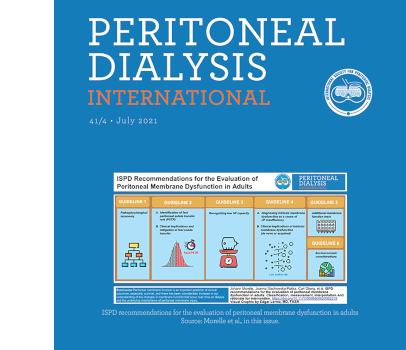Le registre REIN est un registre national mis en place à la demande des néphrologues et dont le support institutionnel est l’Agence de la biomédecine. Une étude spécifique a été menée sur la cohorte de patients en insuffisance rénale chronique terminale inscrits dans ce registre et ayant débuté la dialyse en 2017. A partir d’un modèle de régression logistique, l'objectif de l’étude était d'évaluer l'association entre la défaveur sociale estimée par l’indice européen EDI (European Deprivation Index) et la prise en charge des patients par dialyse péritonéale à 3 mois du démarrage de la dialyse, et d’identifier les variables potentielles associées.
Effect of social deprivation on peritoneal dialysis uptake: A mediation analysis with the data of the REIN registry
Mathilde Beaumier, Eve Calvar, Ludivine Launay, Clémence Béchade, Antoine Lanot, Nicole Schauder, Fatouma Touré, Mathilde Lassalle, Cécile Couchoud, Valérie Châtelet, Thierry Lobbedez, on behalf of the REIN registry
Peritoneal Dialysis International: Journal of the International Society for Peritoneal Dialysis
First Published July 1, 2021
https://doi.org/10.1177/08968608211023268
Abstract
Social deprivation could act as a barrier to peritoneal dialysis (PD). The objective of this study was to assess the association between social deprivation estimated by the European deprivation index (EDI) and PD uptake and to explore the potential mediators of this association.
From the Renal Epidemiology and Information Network registry, patients who started dialysis in 2017 were included. The EDI was calculated based on the patient’s address. The event of interest was the proportion of PD 3 months after dialysis initiation. A mediation analysis with a counterfactual approach was carried out to evaluate the direct and indirect effect of the EDI on the proportion of PD.
Among the 9588 patients included, 1116 patients were on PD; 2894 (30.2%) patients belonged to the most deprived quintile (Q5). PD was associated with age >70 years (odds ratio (OR) 0.79 [95% confidence interval (CI): 0.69–0.91]), male gender (0.85 [95% CI: 0.74–0.97]), cardiovascular disease (OR 0.86 [95% CI: 0.86–1.00]), chronic heart failure (OR 1.34 [95% CI: 1.13–1.58]), active cancer (OR 0.67 [95% CI: 0.53–0.85]) and obesity (OR 0.75 [95% CI: 0.63–0.89]). In the mediation analysis, Q5 had a direct effect on PD proportion OR 0.84 [95% CI: 0.73–0.96]. The effect of Q5 on the proportion of PD was mediated by haemoglobin level at dialysis initiation (OR 0.96 [95% CI: 0.94–0.98]) and emergency start (OR 0.98 [95% CI: 0.96–0.99]).
Social deprivation, estimated by the EDI, was associated with a lower PD uptake. The effect of social deprivation was mediated by haemoglobin level, a proxy of predialysis care and emergency start.

